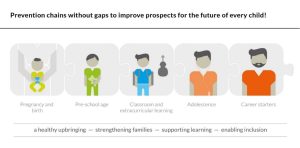For a successful approach to the wellbeing of all children, and especially for those in need, it is crucial to look at the challenges in their life from the perspective of the child and his or her family.
In Germany, but also in many other European countries, we can see a paradigm shift on the issues of education, early childhood care, social security and health from an administrative point of view.
In 2012, North Rhine-Westphalia’s former Minister President launched the “Leave No Child Behind” initiative in cooperation with the Bertelsmann Stiftung. The initiative aims to overcome the division of administrative and financial responsibilities in local authorities regarding a child’s needs in matters of health, education and social security.
The following aspects show what is needed:
- The introduction and implementation of a strategic agenda
- Inter-administrative cooperation in operational and financial matters
- Focus on the welfare of the child
- Evidence-based and effect-oriented community actions
- Preventive measures linked to regular institutions and offers, especially to medical services
- Prevention starting in early childhood and strengthening parents and their competencies
“Leave No Child Behind” is not the only German initiative addressing education, social welfare and health from an administrative point of view. However, prevention and a neighbourhood-centered approach are still neither consolidated nor comprehensive at the national level and depend heavily on the goodwill and skills of local actors.
Since 2012, the Bertelsmann Stiftung has been responsible for accompanying research. This research has shown that we need to strengthen community coordination in Germany and ensure that no child is left behind. The social environment has the most significant influence on the future of children and young people; yet diagnostics, evidence-based procedures, controlling and impact analyses are underdeveloped in most communities. In addition, hard-to-reach target groups in particular can be reached very well through health care, while at the same time these access points are the least developed.
In order to find out more about how national structures need to be set up to ensure that socio-spatial approaches and life-course-oriented prevention can work, the Bertelsmann Stiftung is conducting a comparative European study on “Governance and incentive structures for improving municipal prevention policies for children and young people in a European comparison. We will present initial results at the European Social Service Conference, together with our project partners from the Austrian cities of Graz and Vienna, the Dutch Institute for Youth Welfare and the Free and Hanseatic City of Hamburg. All partners will show how challenges related to administrative structures and child welfare can be overcome and how efficiently they can reach children in disadvantaged life situations if the focus is on the perspective of the child and the family.


